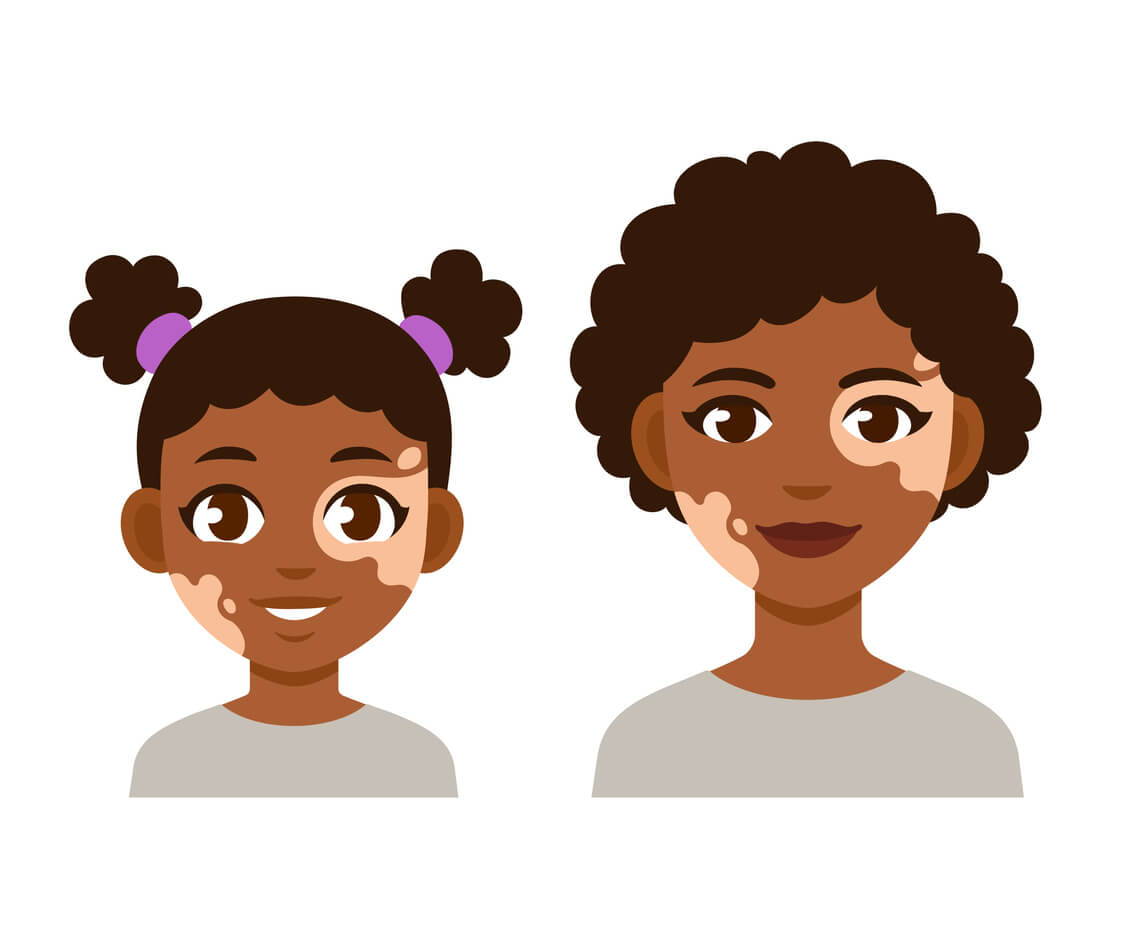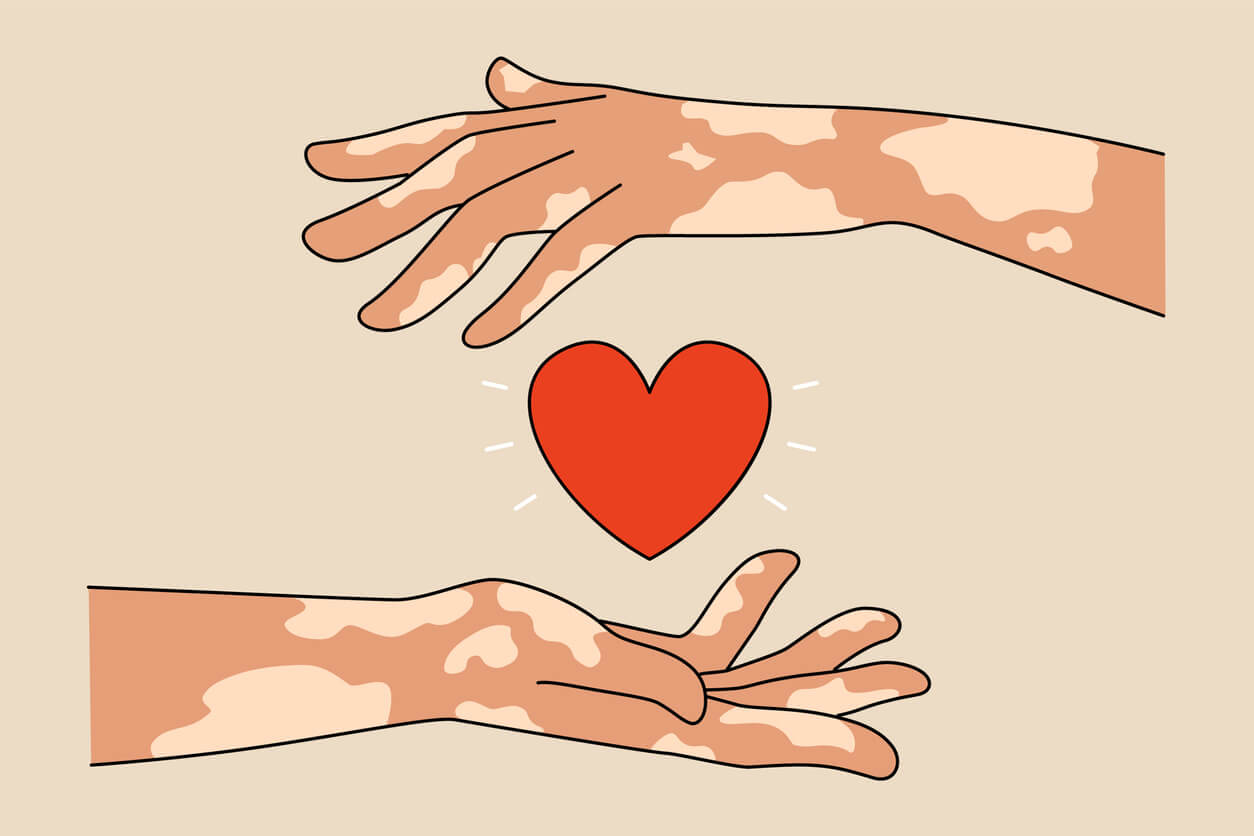Vitiligo in Children: Symptoms, Causes, and Treatment

What is vitiligo?
Vitiligo is a chronic skin pigmentation disorder caused by the progressive loss of melanocytes (or pigment cells) and an alteration in their function. This phenomenon results in the formation of lighter areas of skin tissue, which over time, completely lose their color.
Some studies conclude that half of the people with vitiligo manifest the disease before the age of 20 and that 25% of them do so before the age of 8. However, studies have not shown a higher incidence of vitiligo according to sex, race, or age.

Read also: White Spots on Children’s Skin
Symptoms of vitiligo in children
As mentioned above, vitiligo is characterized by the presence of white macules of variable size and shape, which don’t cause symptoms. In most cases, they’re located in the folds of the body, in the peri-orificial areas, and in the areas most exposed to the sun.
However, other parts of the body can also be affected, either on the skin surface or mucosa. For example, some people may have hypopigmented areas in the ears, eyes, brain, lungs, and heart.
Rarely, children may have an alteration of the melanocytes in the hair follicles, and this is manifested by colorless or depigmented hair.
Also, new lesions may develop after trauma to the skin and this is known as Köebner’s phenomenon.
It should be noted that vitiligo in children can represent an important psychological trauma, both for them and for their parents, which translates into poor quality of life for the whole family group.
What are the most common causes?
There are several hypotheses to try to explain the cause of vitiligo, but the most relevant one suggests a combination of immunological and genetic factors that cause the destruction of the melanocytes themselves. For this reason, the disease is considered to be autoimmune.
In addition to genetic factors, there are also different environmental factors that can trigger the disease:
- Physical stress: Accidents, surgery, serious illnesses
- Malnutrition
- Endocrine factors, such as pregnancy
- Chemical factors: Phenols, thiols, mercaptoamines, quinones, or derivatives
- Sunburns
- Intercurrent infections and repeated intake of antibiotics
Treatments for vitiligo in children
The goal of any therapeutic option is to restore the normal appearance, morphology, and function of the skin.
Treatments for vitiligo in children are usually divided into medical and surgical options. In turn, there are two instances of intervention:
- The initial stage, to stop the progression of the disease.
- The stage of stimulation of pigmentation of the macules.
You may be interested in: Pityriasis Versicolor in Adolescents: What You Should Know
Topical therapies for vitiligo in children
Within the range of possibilities for treating vitiligo locally are the following drugs:
- Corticosteroids: Low, medium, or high potency topical steroids are usually the first line of treatment, due to their ease of management. Studies report a 45-60% response rate in vitiligo manifestations in children.
- Calcipotriol: This is a vitamin D3 analog, which is applied once a day on the lesions for varying periods. However, it has transient adverse effects, such as mild burning and skin irritation. It can be used in combination with corticosteroids.
- Calcineurin inhibitors: These have fewer side effects compared to long-term topical steroids. The most commonly used are tacrolimus and pimecrolimus.
Systemic therapy
When the disease is unstable, it’s important to resort to systemic treatment with oral corticosteroids. These drugs have the ability to stop the progression of vitiligo and produce new skin pigmentation.
Pulse therapy with dexamethasone and betamethasone is an effective treatment modality to stop the progression of vitiligo and also to induce spontaneous pigmentation.
Phototherapy (narrow band UVB)
The mechanism of action of this treatment is through its immunomodulatory effects. This stops the progression of the disease and stimulates the remaining undamaged melanocytes in the skin.
In the beginning, treatments consist of 3 doses per week, as it’s difficult to estimate the minimum dose of erythema in the child. Better responses are usually seen in lesions on the face and trunk.
Surgical treatments
Surgical therapy isn’t the first-line option for treating vitiligo in children. Melanocyte transplantation includes the following procedures:
- Minipuncture grafts
- Epidermal suction ampoule grafts
- Transplantation of epidermal cell suspension
- Thin grafts (Thiersch operation)
- Cultured melanocyte suspension
- Cultured epidermis

Vitiligo and children
In addition to the treatments mentioned above, it’s a good idea to implement some dietary changes, including some sources of vitamin A, vitamin C, and vitamin D.
It should be noted that vitiligo is a disease that should be managed in a multidisciplinary manner, with the collaboration of different specialties, such as endocrinology, rheumatology, psychology, and gastroenterology. If your child presents clinical signs compatible with this disease, consult your family doctor. There are ways to address the problem and improve your child’s quality of life.
All cited sources were thoroughly reviewed by our team to ensure their quality, reliability, currency, and validity. The bibliography of this article was considered reliable and of academic or scientific accuracy.
- Halder RM, Grimes PE, Cowan CA, Enterline JA, Chakrabarti SG, Kenney JA Jr. Childhood vitiligo. J Am Acad Dermatol. 1987 May;16(5 Pt 1):948-54. doi: 10.1016/s0190-9622(87)70119-4. PMID: 3584578.
- Koranne RV, Sachdeva KG. Vitiligo. Int J Dermatol. 1988 Dec;27(10):676-81. doi: 10.1111/j.1365-4362.1988.tb01260.x. PMID: 3069756.
- Hann SK, Park YK, Chun WH. Clinical features of vitiligo. Clin Dermatol. 1997 Nov-Dec;15(6):891-7. doi: 10.1016/s0738-081x(97)00130-2. PMID: 9404692.
- Gupta S, Kumar B. Epidermal grafting for vitiligo in adolescents. Pediatr Dermatol. 2002 Mar-Apr;19(2):159-62. doi: 10.1046/j.1525-1470.2002.00035.x. PMID: 11994184.
- Ezzedine K, Eleftheriadou V, Whitton M, van Geel N. Vitiligo. Lancet. 2015 Jul 4;386(9988):74-84. doi: 10.1016/S0140-6736(14)60763-7. Epub 2015 Jan 15. PMID: 25596811.